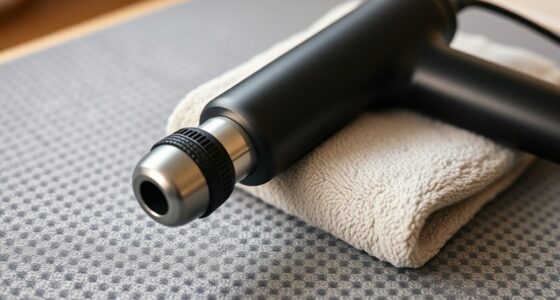Vibration frequency measures how fast objects like percussion instruments vibrate, expressed in Hertz (Hz). When you strike a drum or cymbal, it vibrates at a specific speed, creating sound waves heard by your ears. The faster the vibration, the higher the pitch. Understanding these speeds helps you grasp how different percussion sounds are produced and resonate. Keep exploring to uncover how these vibrations influence musical tone and resonance.
Key Takeaways
- Vibration frequency measures how fast percussion instruments like drums or cymbals vibrate, producing different sound pitches.
- Higher percussion speeds correspond to higher frequencies, resulting in higher-pitched sounds.
- Understanding natural frequencies helps explain resonance effects in percussion instruments.
- Measurement tools like oscilloscopes can quantify percussion vibration speeds accurately.
- Mastering percussion speeds enhances sound control and musical expression in percussion performance.

Have you ever wondered what makes a tuning fork vibrate or why a guitar string produces different sounds? The answer lies in the fascinating world of vibration frequency, a fundamental concept that explains how objects produce sound and how their vibrations can be measured and understood. When an object vibrates, it creates tiny pressure waves in the air, which your ears interpret as sound. The rate at which these vibrations occur is called the frequency, typically measured in Hertz (Hz). Understanding this frequency is essential to grasping how musical instruments work, how resonance phenomena develop, and how scientists measure and analyze vibrations. The natural frequency of an object determines how it responds to external stimuli and influences its vibrational behavior.
Resonance phenomena occur when an object vibrates at a frequency that matches its natural frequency, amplifying the sound. For example, when you strike a tuning fork, it vibrates at a specific frequency, which can cause nearby objects with similar frequencies to resonate, producing louder sounds. This phenomenon isn’t just limited to musical instruments; it plays a role in many fields, including engineering and physics. Recognizing resonance helps you understand why certain vibrations grow stronger or weaker depending on conditions, which is vital for designing buildings, bridges, and musical instruments.
To explore these vibrations further, you need effective frequency measurement techniques. Traditional methods involve using devices like frequency counters and oscilloscopes, which can detect and display the vibrational frequency of an object accurately. These tools allow you to quantify the rate of vibration directly, helping you analyze the behavior of different objects under various conditions. Modern techniques also incorporate digital sensors and software that record vibrations and perform detailed analysis, giving you a clearer picture of how objects vibrate over time. Whether you’re tuning a musical instrument or studying structural integrity, mastering these techniques is essential for precise measurement.
Frequently Asked Questions
How Does Vibration Frequency Affect Musical Instrument Tuning?
You might notice that vibration frequency plays a big role in musical instrument tuning. Higher frequencies can cause resonance effects, amplifying certain sounds and affecting clarity. If the vibration frequency isn’t precise, tuning stability suffers, leading to off-pitch notes. By controlling vibration frequency, you guarantee consistent resonance effects and maintain accurate tuning, so your instrument sounds harmonious and well-balanced every time you play.
What Is the Relationship Between Vibration Frequency and Sound Pitch?
You know what they say, “what you hear is what you get.” Vibration frequency directly influences sound pitch because higher frequencies produce higher pitches, while lower ones create deeper sounds. Resonance phenomena amplify these vibrations, making the pitch more prominent. Frequency modulation allows you to alter the vibration frequency, therefore changing the sound pitch. So, your perception of pitch hinges on the vibration frequency and how resonance and modulation shape it.
Can Vibration Frequency Influence Human Perception of Sound Quality?
Vibration frequency certainly influences your perception of sound quality by shaping the sound wave your auditory system detects. Higher frequencies often produce brighter, sharper sounds, while lower frequencies create deeper tones. Your auditory perception is sensitive to these differences, affecting how you experience music or speech. So, variations in vibration frequency can make sounds seem richer, clearer, or more dull, directly impacting your overall listening experience.
How Do Different Materials Affect Vibration Frequency in Devices?
Imagine how your device’s material properties shape its vibration frequency, creating unique sounds. Different materials, like metal or plastic, influence resonance effects, altering how vibrations behave. This happens because each material’s density, elasticity, and damping characteristics change the way vibrations travel and sustain, affecting sound quality and device performance. So, by choosing specific materials, you can fine-tune vibration frequencies to optimize your device’s function and sound output.
What Role Does Vibration Frequency Play in Medical Ultrasound Technology?
Vibration frequency is essential in medical ultrasound technology because it determines the resolution and depth of tissue diagnostics and ultrasound imaging. Higher frequencies provide clearer images of superficial tissues, while lower frequencies penetrate deeper but with less detail. You rely on adjusting vibration frequencies to optimize diagnostic accuracy, ensuring you get precise, real-time visuals that help identify conditions and guide treatments effectively.
Conclusion
Now that you understand vibration frequency, now that you grasp percussion speeds, now that you see how they influence sound and motion, you can appreciate the power behind each beat. Recognize how these vibrations shape your experience, how they drive the rhythm of life around you. Embrace the knowledge that every tap, every pulse, and every oscillation connects you to a deeper understanding of motion, music, and the world’s constant, vibrant energy.









